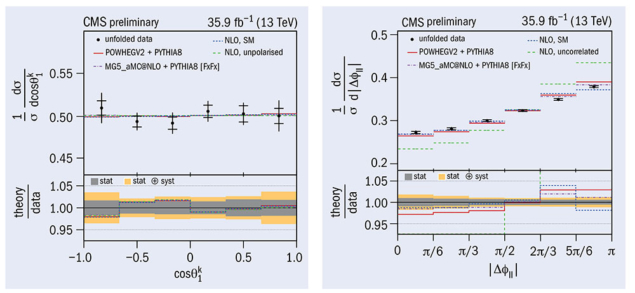
One of the most fascinating particles studied at the LHC is the top quark. As the heaviest elementary particle to date, the top quark lives for less than a trillionth of a trillionth of a second (10–24 s) and decays long before it can form hadrons. It is also the only quark that provides the possibility to study a bare quark. This allows physicists to explore its spin, which is related to the quark’s intrinsic quantum angular momentum. The spin of the top quark can be inferred from the particles it decays into: a bottom quark and a W boson, which subsequently decays into leptons or quarks.
The CMS collaboration has analysed proton–proton collisions in which pairs of top quarks and antiquarks are produced. The Standard Model (SM) makes precise predictions for the frequency at which the spin of the top quark is aligned with (or correlated to) the spin of the top antiquark. A measure of this correlation is thus a highly sensitive test of the SM. If, for example, an exotic heavier Higgs boson were to exist in addition to the one discovered in 2012 at the LHC, it could decay into a pair of top quarks and antiquarks and change their spin correlation significantly. A high-precision measurement of the spin correlation therefore opens a window to explore physics beyond our current knowledge.
The CMS collaboration studied more than one million top-quark–antiquark pairs in dilepton final states recorded in 2016. To study all the spin and polarisation effects accessible in top-quark–antiquark pair production, nine event quantities sensitive to top-quark spin and correlations, and three quantities sensitive to the top-quark polarisation were measured. The measured observables were corrected for experimental effects (“unfolded”) and directly compared to precise theoretical predictions.
The observables studied in this analysis show good agreement between data and theory, for example showing no angular dependence for unpolarised top quarks (see figure 1, left). A moderate discrepancy is seen in one of the measured distributions sensitive to spin (the azimuthal opening angle between two leptons), with respect to one of the Monte Carlo simulations (POWHEGv2+PYTHIA). This discrepancy is consistent with an observation made by the ATLAS collaboration last year, although CMS finds that other simulations (“MG5_aMC@NLO”) and calculations that should give similar results agree with the data within the uncertainties.
In summary, a good agreement with the SM prediction is observed in CMS data, except for the case of one particular but commonly used observable, suggesting further input from theory calculations is probably necessary. The full Run-2 data set already recorded by CMS contains four times more top quarks than were used for this result. This larger sample will allow an even more precise measurement, increasing the chances for a first glimpse of new physics.
Further reading
CMS Collaboration 2018 CMS-PAS-TOP-18 006.
ATLAS Collaboration 2018 ATLAS-CONF-2018-027.








